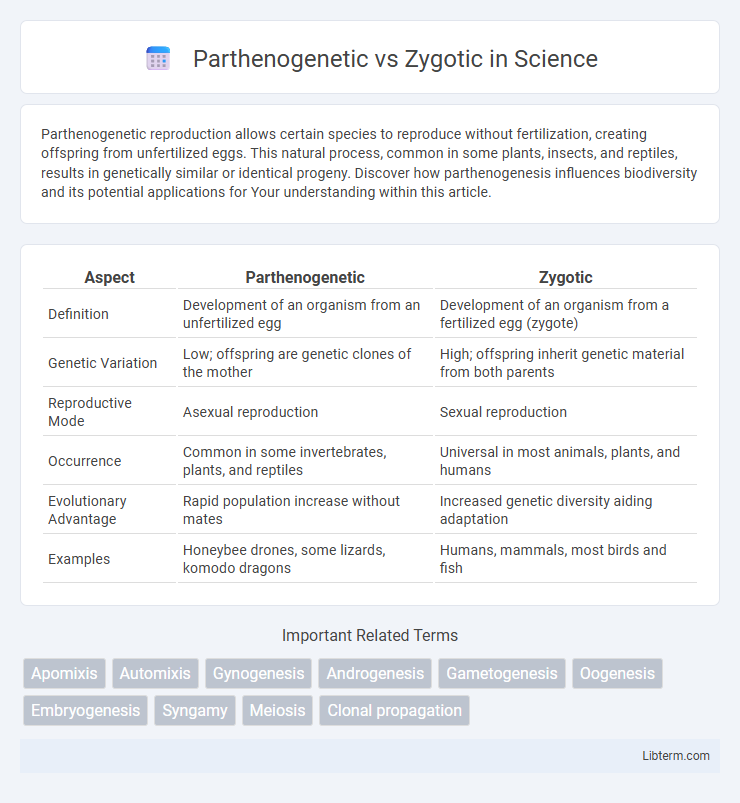Parthenogenetic reproduction allows certain species to reproduce without fertilization, creating offspring from unfertilized eggs. This natural process, common in some plants, insects, and reptiles, results in genetically similar or identical progeny. Discover how parthenogenesis influences biodiversity and its potential applications for Your understanding within this article.
Table of Comparison
| Aspect | Parthenogenetic | Zygotic |
|---|---|---|
| Definition | Development of an organism from an unfertilized egg | Development of an organism from a fertilized egg (zygote) |
| Genetic Variation | Low; offspring are genetic clones of the mother | High; offspring inherit genetic material from both parents |
| Reproductive Mode | Asexual reproduction | Sexual reproduction |
| Occurrence | Common in some invertebrates, plants, and reptiles | Universal in most animals, plants, and humans |
| Evolutionary Advantage | Rapid population increase without mates | Increased genetic diversity aiding adaptation |
| Examples | Honeybee drones, some lizards, komodo dragons | Humans, mammals, most birds and fish |
Introduction to Parthenogenetic and Zygotic Reproduction
Parthenogenetic reproduction involves the development of offspring from an unfertilized egg, resulting in clones genetically identical to the mother, commonly observed in certain reptiles, insects, and plants. Zygotic reproduction requires the fusion of male and female gametes, forming a zygote that combines genetic material from both parents, which is the primary mode in most animals and flowering plants. Understanding these reproductive strategies is essential for studies in genetics, evolutionary biology, and conservation.
Defining Parthenogenesis
Parthenogenesis is a form of asexual reproduction in which an organism develops from an unfertilized egg, resulting in offspring genetically identical to the mother. This process contrasts with zygotic reproduction, where genetic material from two parents combines to form a zygote, ensuring genetic diversity. Parthenogenetic species, such as certain reptiles and insects, bypass fertilization, enabling rapid population growth in stable environments.
Overview of Zygotic Reproduction
Zygotic reproduction involves the fusion of two haploid gametes to form a diploid zygote, initiating genetic diversity and organismal development. This mode of reproduction is fundamental in sexually reproducing species, ensuring the exchange and recombination of genetic material. The resulting zygote undergoes multiple rounds of cell division and differentiation, forming a multicellular organism with inherited traits from both parents.
Key Differences Between Parthenogenetic and Zygotic Processes
Parthenogenetic reproduction occurs without fertilization, resulting in offspring genetically identical to the mother, while zygotic reproduction involves the fusion of male and female gametes, producing genetically diverse offspring. Parthenogenesis is common in some invertebrates and plants, whereas zygotic development is predominant in most animals, including humans. The genetic variation in zygotic processes enhances adaptability, contrasting with the clonal nature of parthenogenetic offspring.
Genetic Diversity in Parthenogenetic vs Zygotic Offspring
Parthenogenetic offspring arise from a single parent's genetic material, resulting in limited genetic diversity due to the absence of genetic recombination. In contrast, zygotic reproduction involves the fusion of gametes from two parents, promoting high genetic diversity through the combination of different alleles. This increased genetic variability in zygotic offspring enhances adaptability and evolutionary potential in changing environments.
Occurrence in the Animal and Plant Kingdoms
Parthenogenetic reproduction occurs predominantly in certain invertebrates like aphids, bees, and some reptiles, as well as in some plant species such as dandelions, enabling offspring development from unfertilized eggs. Zygotic reproduction, involving the fusion of male and female gametes, is the prevalent reproductive mode in most animals, including mammals, birds, and amphibians, and in the majority of flowering plants and gymnosperms. While parthenogenesis allows rapid population increase under favorable conditions, zygotic reproduction promotes genetic diversity essential for adaptation and evolution across diverse taxa.
Evolutionary Advantages and Disadvantages
Parthenogenetic reproduction enables rapid population growth and colonization without the need for mates, offering evolutionary advantages in stable environments but limiting genetic diversity, which can reduce adaptability to changing conditions. Zygotic reproduction promotes genetic recombination, increasing variation essential for evolutionary resilience and adaptation, yet it requires more energy and time investment for mate finding and fertilization. The balance between these modes influences species survival strategies, with parthenogenesis favored in predictable habitats and zygotic reproduction advantageous amid environmental fluctuations.
Case Studies: Examples in Nature
Parthenogenetic reproduction occurs in species like the whiptail lizards (genus Aspidoscelis), where females produce offspring without fertilization, demonstrating a form of asexual reproduction. Zygotic reproduction, commonly seen in mammals such as humans, involves the fusion of male and female gametes to form a genetically distinct zygote. Case studies of parthenogenesis in Komodo dragons reveal occasional facultative parthenogenetic events, contrasting with the obligatory zygotic sexual reproduction observed in most vertebrates.
Applications in Biotechnology and Agriculture
Parthenogenetic reproduction enables the production of genetically uniform offspring, making it valuable for cloning elite plants and animals in biotechnology and agriculture, promoting consistent yield and quality. Zygotic reproduction, involving genetic recombination, fosters genetic diversity critical for breeding programs aimed at developing disease-resistant and high-yield crop varieties. These reproductive strategies complement each other, with parthenogenesis accelerating mass propagation and zygotic mechanisms driving long-term genetic improvement and adaptability.
Future Research Directions and Implications
Future research on parthenogenetic versus zygotic development should explore molecular mechanisms governing genomic imprinting and epigenetic regulation to enhance cloning efficiency and developmental stability. Investigating CRISPR-Cas9 genome editing in parthenogenetic embryos offers potential for disease modeling and regenerative medicine applications. Understanding the evolutionary implications and potential for artificial reproduction technologies could revolutionize biodiversity conservation and reproductive health.
Parthenogenetic Infographic

 libterm.com
libterm.com